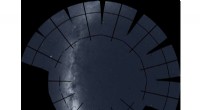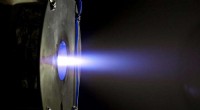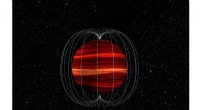
Wetenschap
NASA opent maansteenmonsters die zijn verzegeld sinds Apollo-missies (update)
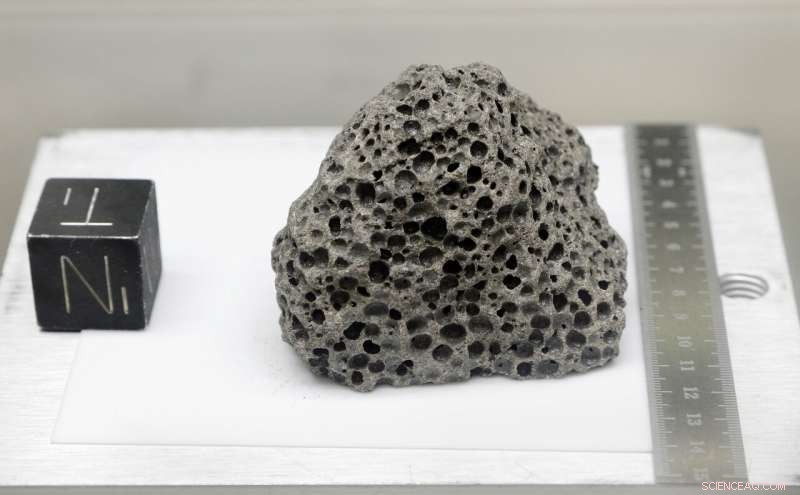
Verzameld tijdens Apollo 15, een 3,5 miljard jaar oud basaltgesteente vergelijkbaar met rotsen gevormd rond Hawaï, wordt weergegeven in een met stikstof gevulde onderzoekskoffer onder druk in het maanlab in het NASA Johnson Space Center maandag, 17 juni 2019, in Houston. Voor het eerst in decennia, NASA staat op het punt enkele van de ongerepte monsters te openen en geologen er met 21e-eeuwse technologie naar te laten kijken. (AP Foto/Michael Wyke)
In een afgesloten kluis in het Johnson Space Center is een schat die maar weinigen hebben gezien en minder hebben aangeraakt.
Het beperkte laboratorium herbergt honderden kilo's maanstenen die bijna een halve eeuw geleden door Apollo-astronauten zijn verzameld. En voor het eerst in decennia, NASA staat op het punt enkele van de ongerepte monsters te openen en geologen te laten onderzoeken met 21e-eeuwse technologie.
Wat is een betere manier om deze zomer de 50e verjaardag van de eerste voetstappen van de mensheid op de maan te vieren dan door een beetje van de maanbuit te delen.
"Het is een beetje toeval dat we ze openen in het jaar van het jubileum, " verklaarde NASA's Apollo-voorbeeldcurator Ryan Zeigler, van top tot teen bedekt in een wit beschermend pak met bijpassende stoffen laarzen, handschoenen en muts.
"Maar het jubileum heeft zeker het bewustzijn vergroot en het feit dat we teruggaan naar de maan."
Met de gouden verjaardag van de prestatie van Neil Armstrong en Buzz Aldrin die snel nadert - hun maanmodule Eagle landde op 20 juli, 1969, op de Zee van Rust - de maan is weer roodgloeiend.
Na decennia van flip-floppen tussen de maan en Mars als de volgende grote astronautenbestemming, NASA streeft ernaar astronauten tegen 2024 weer op het maanoppervlak te plaatsen op aanwijzing van het Witte Huis. President Donald Trump praat liever over Mars. Maar de consensus is dat de maan een cruciaal proefterrein is, gezien de relatieve nabijheid van thuis - 240, 000 mijl (386, 000 kilometer) of twee tot drie dagen weg.

De Genesis-rots, voorgrond, een 4,4 miljard jaar oud anorthosiet gesteente, ongeveer 2 inch lang, teruggebracht door Apollo 15 en gebruikt om te bepalen dat de maan werd gevormd door een gigantische impact, zit onder glas in een met stikstof gevulde onderzoekskoffer onder druk als Lacey Costello, een Apollo sample curation processor, werkt met andere monsters aan de buitenkant van de behuizing in het maanlab in het NASA Johnson Space Center maandag, 17 juni 2019, in Houston. (AP Foto/Michael Wyke)
Het is de taak van Zeigler om te behouden wat de 12 moonwalkers meebrachten van 1969 tot 1972 - maanmonsters van in totaal 842 pond (382 kilogram) - en ervoor te zorgen dat wetenschappers de best mogelijke monsters voor studie krijgen.
Een deel van de grond en stukjes rots werden vacuüm verpakt op de maan - en nooit blootgesteld aan de atmosfeer van de aarde - of bevroren of opgeslagen in gasvormig helium na het neerspatten en vervolgens onaangeroerd gelaten. Het laboratoriumpersoneel probeert nu uit te zoeken hoe de monsters het beste uit hun buizen en andere containers kunnen worden verwijderd zonder iets te besmetten of te bederven. Ze oefenen met namaakapparatuur en doen alsof ze maanvuil zijn.
Vergeleken met technologie uit het Apollo-tijdperk, de huidige wetenschappelijke instrumenten zijn veel gevoeliger, merkte Zeigler op.
"We kunnen meer doen met een milligram dan we toen met een gram konden doen. Dus het was echt een goede planning van hun kant om te wachten, " hij zei.
Het laboratorium voor maanmonsters heeft twee naast elkaar liggende gewelven:een voor stenen die nog recht van de maan zijn en een kleinere kluis voor monsters die eerder zijn uitgeleend voor studie. Ongeveer 70 procent van de oorspronkelijke vangst bevindt zich in de ongerepte monsterkluis, die twee combinaties heeft en twee mensen nodig heeft om te ontgrendelen. Ongeveer 15 procent is in bewaring bij White Sands in New Mexico. De rest wordt gebruikt voor onderzoek of tentoonstelling.
-

Jeremy Kent, Apollo curator, werkt met maanmonsters in een afgesloten, stikstof-onder druk staande onderzoekscase in het maanlab in het NASA Johnson Space Center maandag, 17 juni 2019, in Houston. De monsters worden altijd in een stikstofomgeving bewaard om bederf en degradatie te voorkomen, zelfs als ze tussen het lab en de opslagkluis worden verplaatst. (AP Foto/Michael Wyke)
-
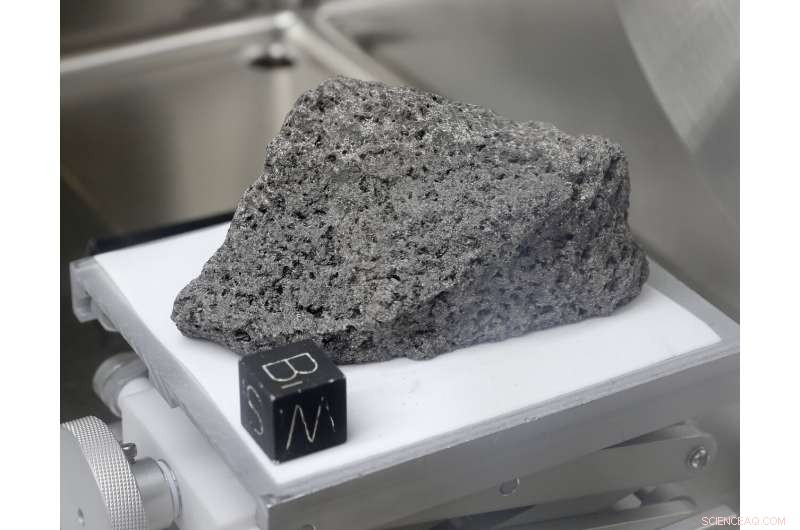
Verzameld tijdens Apollo 17, een 3,5 miljard jaar oude basaltsteen bekend als "The Children of the World" of "The Goodwill Sample" wordt maandag getoond in het maanlab in het NASA Johnson Space Center, 17 juni 2019, in Houston. Het werd gebruikt om monsters te maken die aan elk land ter wereld werden geschonken. (AP Foto/Michael Wyke)
-

Collected during Apollo 16, an anorthosite sample believed to be the oldest rock collected during the moon missions is displayed in the lunar lab at the NASA Johnson Space Center Monday, June 17, 2019, in Houston. Scientists also believe it to be from the original crust of the moon just after it cooled. (AP Photo/Michael Wyke)
-

The "Genesis Rock, " a 4.4 billion-year-old anorthosite sample approximately 2 inches in length, brought back by Apollo 15 and used to determine the moon was formed by a giant impact, is lit inside a pressurized nitrogen-filled examination case in the lunar lab at the NASA Johnson Space Center Monday, June 17, 2019, in Houston. (AP Photo/Michael Wyke)
-

A regolith breccia rock of sintered lunar soil, dating 3.2 billion years old and collected by Apollo 15, is displayed in a pressurized nitrogen-filled case inside the lunar lab at the NASA Johnson Space Center Monday, June 17, 2019, in Houston. (AP Photo/Michael Wyke)
-
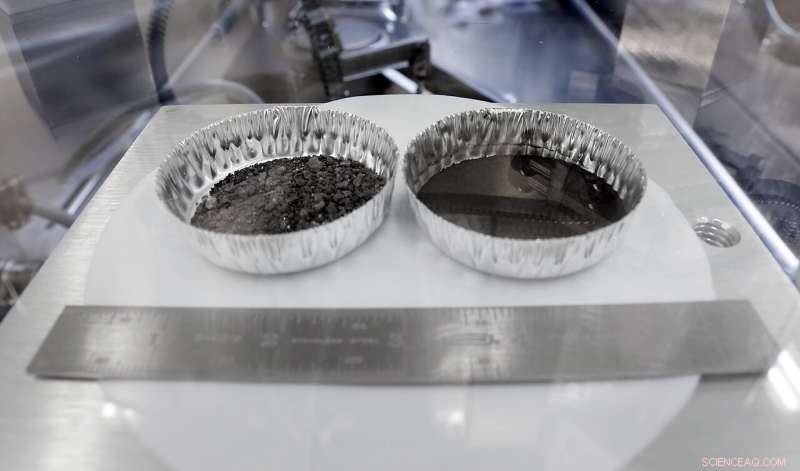
Two separate 2 inch foil pans hold lunar dirt, from the last shovel full collected by Neil Armstrong on the Apollo 11, in the lunar lab at the NASA Johnson Space Center Monday, June 17, 2019, in Houston. (AP Photo/Michael Wyke)
-

Ryan Zeigler, Apollo sample curator, links, stands next to a nitrogen-filled case displaying various lunar samples collected during Apollo missions 15, 16 and 17, inside the lunar lab at the NASA Johnson Space Center Monday, June 17, 2019, in Houston. (AP Photo/Michael Wyke)
-
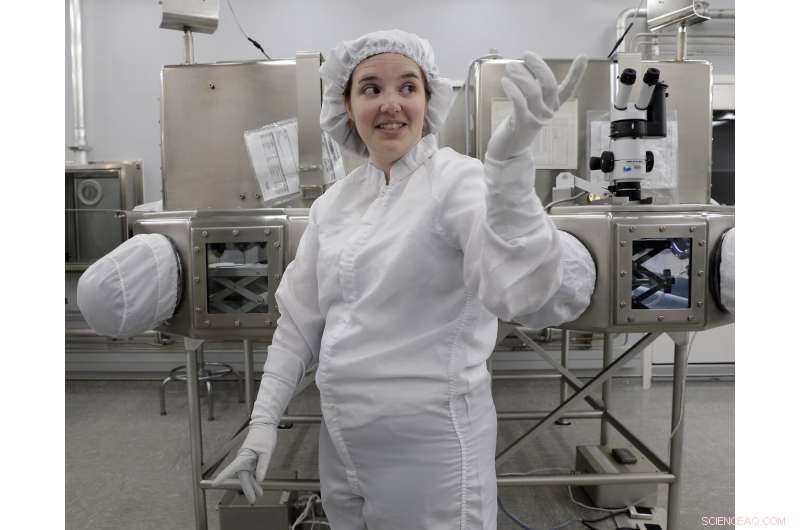
Lacey Costello, Apollo sample curation processor, talks about her job examining lunar samples inside the lunar lab at the NASA Johnson Space Center Monday, June 17, 2019, in Houston. (AP Photo/Michael Wyke)
-
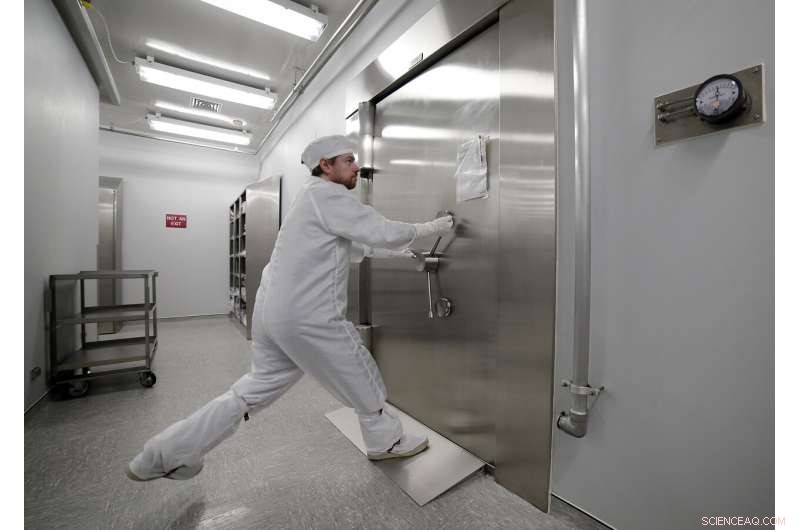
Jeremy Kent, Apollo sample curation processor, tugs to open the 1978 U.S. federal bank vault that protects the entrance to the lunar sample vault inside the lunar lab at the NASA Johnson Space Center Monday, June 17, 2019, in Houston. The door requires two separate combinations, held by two separate people, to open. (AP Photo/Michael Wyke)
Of the six manned moon landings, Apollo 11 yielded the fewest lunar samples:48 pounds or 22 kilograms. It was the first landing by astronauts and NASA wanted to minimize their on-the-moon time and risk. What's left from this mission—about three-quarters after scientific study, public displays and goodwill gifts to all countries and U.S. states in 1969—is kept mostly here at room temperature.
Armstrong was the primary rock collector and photographer. Aldrin gathered two core samples just beneath the surface during the 2 1/2-hour moonwalk. All five subsequent Apollo moon landings had longer stays. The last three—Apollo 15, 16 and 17—had rovers that significantly upped the sample collection and coverage area.
"Fifty years later, we're still learning new things ... incredible, " said the lab's Charis Krysher, holding a clear acrylic marble embedded with chips of Apollo 11 moon rock in her gloved hand.
By studying the Apollo moon rocks, Zeigler said, scientists have determined the ages of the surfaces of Mars and Mercury, and established that Jupiter and the solar system's other big outer planets likely formed closer to the sun and later migrated outward.
"So sample return from outer space is really powerful about learning about the whole solar system, " hij zei.
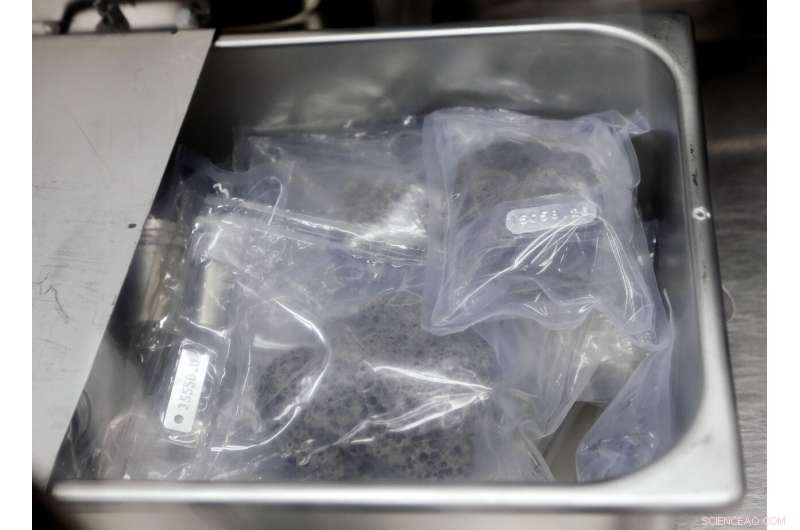
A stainless steel bin is opened to show individually tagged and sealed lunar samples collected during Apollo 16 inside a pressurized nitrogen-filled case holding the samples from that mission in the lunar lab of the NASA Johnson Space Center Monday, June 17, 2019, in Houston. (AP Photo/Michael Wyke)
Andrea Mosie, who's worked with the Apollo moon rocks for 44 years and was a high school intern at Johnson Space Center in July 1969, remembers the Polaroid photos and handwritten notes once accompanying each sample. She sometimes gets emotional when talking to children about the moonshots and does her best to dispel any notion that the rocks aren't from the moon and the lunar landings never happened.
"The samples are right here and they're still in a pristine state, " she assures young skeptics.
Most of the samples to be doled out over the next year were collected in 1972 during Apollo 17, the final moonshot and the only one to include a geologist, Harrison Schmitt. He occasionally visits the lunar sample lab and plans to help open the fresh specimens.
The nine U.S. research teams selected by NASA will receive varying amounts.
"Everything from the weight of a paperclip, down to basically so little mass you can barely measure it, " Zeigler said.

Pressurized nitrogen-filled cases hold lunar samples collected from Apollo 11, links, and Apollo 12, Rechtsaf, with NASA's Apollo sample curator Ryan Zeigler in the background, inside the lunar sample vault in the lunar lab at the NASA Johnson Space Center Monday, June 17, 2019, in Houston. The restricted lab is home to hundreds of pounds of moon rocks collected by Apollo astronauts close to a half-century ago. (AP Photo/Michael Wyke)
Especially tricky will be extracting the gases that were trapped in the vacuum-sealed sample tubes. The lab hasn't opened one since the 1970s.
"If you goof that part up, the gas is gone. You only get one shot, " Zeigler said.
The lab's collection is divided by mission, with each lunar landing getting its own cabinet with built-in gloves and stacks of stainless steel bins filled with pieces of the moon. Apollo 16 and 17, responsible for half the lunar haul, get two cabinets apiece.
The total Apollo inventory now exceeds 100, 000 samples; some of the original 2, 200 were broken into smaller pieces for study.
Sample processor Jeremy Kent is hopeful that "we will get some more samples here in the lab to work on."
There's space for plenty more.
© 2019 The Associated Press. Alle rechten voorbehouden.
 Wat zijn de componenten van de atoomstructuur?
Wat zijn de componenten van de atoomstructuur?  Onderzoekers ontwikkelen een vast materiaal met mobiele deeltjes die reageren op de omgeving
Onderzoekers ontwikkelen een vast materiaal met mobiele deeltjes die reageren op de omgeving AI zocht naar single-atom-alloy katalysatoren, 200 veelbelovende kandidaten gevonden
AI zocht naar single-atom-alloy katalysatoren, 200 veelbelovende kandidaten gevonden Ingenieurs krijgen grip op gladde oppervlakteactieve stoffen
Ingenieurs krijgen grip op gladde oppervlakteactieve stoffen Hoe bacteriën mangaanoxide nanodeeltjes produceren
Hoe bacteriën mangaanoxide nanodeeltjes produceren
 HIGH-TOOL ondersteunt transportplanning in Europa
HIGH-TOOL ondersteunt transportplanning in Europa Federale uitgaven voor vuursubsidies kunnen evenwichtiger zijn, nieuw model suggereert:
Federale uitgaven voor vuursubsidies kunnen evenwichtiger zijn, nieuw model suggereert: Milieuchef VS tekent ontwerp terugdraaiing van klimaatplan Obama
Milieuchef VS tekent ontwerp terugdraaiing van klimaatplan Obama Samen regenwater- en stroomherstelprojecten beheren
Samen regenwater- en stroomherstelprojecten beheren Wat zijn de overtuigingen over de oorzaken van ziekte tijdens de Elizabethaanse periode?
Wat zijn de overtuigingen over de oorzaken van ziekte tijdens de Elizabethaanse periode?
Hoofdlijnen
- Uitsterven dreigt voor twee zeldzame vogelsoorten na verwoestende orkanen
- CRISPR gebruiken om warmer te maken, minder vette varkens
- eDNA-tool detecteert invasieve mosselen voordat ze hinderlijk worden
- Kan een naaimachine DNA aan elkaar naaien?
- De chemische samenstelling van uitgeademde lucht uit menselijke longen
- Wat is urushiol?
- Batesiaanse mimiek:hoe copycats zichzelf beschermen
- Cryo-EM-beeldvorming suggereert hoe de dubbele helix scheidt tijdens replicatie
- Wetenschap komt dichter bij het verklaren van de boze dronkaard
 Autorijstroken verwijderen, voertuigen te beperken en de doorvoer te verbeteren om verkeersopstoppingen te verminderen
Autorijstroken verwijderen, voertuigen te beperken en de doorvoer te verbeteren om verkeersopstoppingen te verminderen Vingerafdruk voor de vorming van lachgasemissies
Vingerafdruk voor de vorming van lachgasemissies Hoe COVID het arbeidsrecht verandert
Hoe COVID het arbeidsrecht verandert NASA bereidt zich voor op nieuwe wetenschappelijke vluchten boven de kust van Louisiana
NASA bereidt zich voor op nieuwe wetenschappelijke vluchten boven de kust van Louisiana Duikers vinden Nazi's Enigma-codemachine in Oostzee
Duikers vinden Nazi's Enigma-codemachine in Oostzee Fujitsu ontwikkelt technologie om biochemische reacties te voorspellen, opheldering van de mechanismen van genetische aandoeningen
Fujitsu ontwikkelt technologie om biochemische reacties te voorspellen, opheldering van de mechanismen van genetische aandoeningen Geavanceerde beeldvorming onthult ongebruikelijke, onzichtbare patronen in veren van zeevogels
Geavanceerde beeldvorming onthult ongebruikelijke, onzichtbare patronen in veren van zeevogels Middeleeuws huis van Lords of the Isles vrijwel gereconstrueerd
Middeleeuws huis van Lords of the Isles vrijwel gereconstrueerd
- Elektronica
- Biologie
- Zonsverduistering
- Wiskunde
- French | Italian | Spanish | Portuguese | Swedish | German | Dutch | Danish | Norway |

-
Wetenschap © https://nl.scienceaq.com


